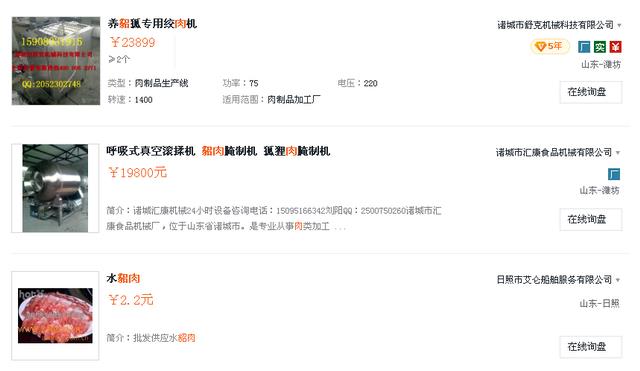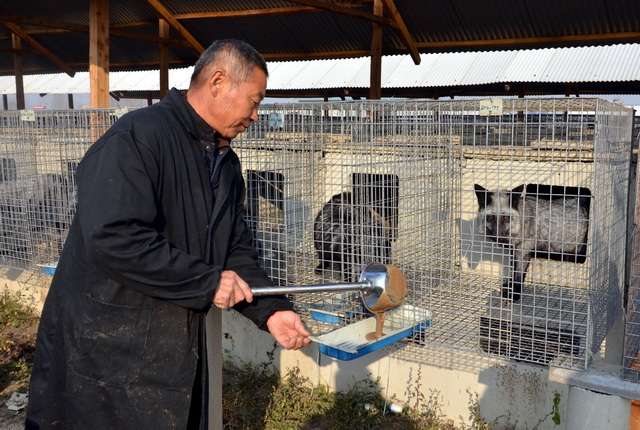The secret of wild animal breeding industry chain: some people collect fur and send it to the slaughterhouse.
In the past few days, many departments have repeatedly issued announcements prohibiting any form of wildlife trading. Many places have also isolated places for raising and breeding wild animals. However, according to the first financial reporter, there are still loopholes in "refusing to eat game".
A number of people in the industry reported to the First Financial Reporter that over the years, wild animal bodies such as fox meat, mink meat and raccoon meat from farms have been sent to slaughterhouses or small workshops to be processed into roast sausages or ham sausages. In some professional journals, there are even experts who guide how to process the meat of these wild animals into delicious food and sell it on the market.
Secrets in the industry?
Changli County, Hebei Province has nearly 30 years of fox, raccoon dog and mink breeding foundation, and the fur industry has become a local characteristic industry. The total number of breeding remains at around 8 million, accounting for one tenth of the country, and the total output of raccoon dogs ranks first in the country.
Changli County is also the largest fur trade center in China, with an annual trade of 15 million fur and 500,000 live animals, with an annual output value of 8 billion to 10 billion yuan. Changli County was awarded the title of "China fur industry base" and "China raccoon dog breeding hometown" by the Specialty Society of China Agricultural Society. The county has formed a complete industrial chain of mink and raccoon breeding, improved seed breeding, feed and veterinary drugs, commerce, processing and logistics.
When the first financial reporter interviewed in the local area, a person in charge of a farm said: "Some people bought fur and some people wanted meat, and sent it to the meat joint factory." When the reporter asked further, the other party seemed a little nervous and just said, "This is a secret that everyone in the industry knows."
A person in charge of a group farm in Hebei told the First Financial Reporter that each raccoon skin can be sold around 500 yuan, and the breeding cost of each raccoon is about 200 yuan, and the benefits are still good. However, if there is a problem in the breeding process, the quality of the leather is not good, and some people do not make money.
Bad leather does not affect the sale of meat.
According to public reports, in June 2014, the Food and Agricultural Products Testing Center of Shandong Inspection and Quarantine Bureau showed the mutton products containing fox meat and mink meat detected by the center.
On a food investment website, the first financial reporter also inquired that mink meat and raccoon meat were for sale. The wholesale price of raccoon meat is 2.2 yuan per kilogram, which is far lower than the price of pork and beef.

A food business network sells information about mink meat and related meat grinding equipment.
There is even a medical science popularization WeChat official account who issued a document saying, "For 2 yuan, if you want to eat beef sausage or pork sausage, it is basically impossible." "A more formal manufacturer will use chicken. Generally, the main ingredients are chicken breasts, chicken skin and duck skin, and then the main flavoring substances — — Pork essence, monascus red pigment, preservative, and filler starch to reduce cost. Some manufacturers may use fox meat, mink meat and so on. Because these meats come from farms, as long as the farms are fur, the meat is generally free. "
On a professional website containing various academic journals, the First Financial Reporter inquired about many papers such as Development and Utilization of Raccoon Meat, Development of Cumin Raccoon Meat Enema, Study on Comprehensive Utilization of Raccoon Byproducts: Utilization of Raccoon Carcass Meat, etc.
Among them, it is mentioned that "raccoon dogs are an important wild animal resource in northeast China, and in recent years, there are many artificial breeding in various places." "Most wild animal farms, after slaughtering and skinning, some smash raccoon meat as feed for fur animals, some dispose of it at a very cheap price, or even discard it", and "processing it into food can create higher profits for farms (households)".
Some experts instructed in the paper that "because the carcass of raccoon dogs is small, it is not easy to be removed, and the meat of raccoon dogs has a slightly earthy smell, so it is made of ‘ Braised canned food ’ The process, and pay attention to adding condiments that can remove the earthy smell in the formula to improve the flavor and palatability of the product. " "In order to eliminate the odor of raccoon meat and improve its edibility, ‘ Spicy Sichuan sausage ’ The formula and its technology, the main processing steps include thawing-cleaning-removing tendons, connective tissues and fat-cutting into small pieces-soaking in clear water-mincing-seasoning-pickling-canning-steaming-smoking, etc. "
Some experts in the industry have also calculated that the average raw material cost per kilogram of sausage is 5.98 yuan. If it is sold at 10 yuan/kg, the gross profit per kilogram can be 4.02 yuan. If 10,000 raccoon dog carcasses are processed every year, 14,737 kilograms of spicy Sichuan sausage can be produced, and the gross profit can be more than 59,000 yuan, with considerable benefits.

A raccoon and mink farm in Changli County, Hebei Province. Photography/Zhangke
There are hidden dangers in the wild animal meat in the farm.
Are wild animal carcasses such as mink meat and raccoon meat from farms safe? According to insiders, unlike pork, beef and mutton, which are subject to strict inspection and quarantine, mink meat and raccoon meat are usually only used for fur, and their meat is usually not included in the range of meat food raw materials, and most of them are not inspected and quarantined.
Experts such as Ren Qiao from the College of Animal Science and Technology of Qingdao Agricultural University introduced that on February 25, 2012, minks in a mink farm in Hongdao, Qingdao developed symptoms and then died in large numbers. The investigation found that the farm was fed with a mixed feed made by itself, and raw fish, chicken head, eggs, pig liver and puffed corn flour were mixed evenly and diluted before feeding. The symptoms of sick mink are depression, loss of appetite or no food. Most minks are paralyzed in hind limbs, with acute onset and high mortality. Through pathological autopsy and laboratory test, the initial diagnosis was Clostridium botulinum poisoning in mink.
Ren Qiao introduced that mink Clostridium botulinum poisoning is an acute fatal poisoning caused by eating meat feed containing Clostridium botulinum toxin. Clostridium botulinum spores are widely distributed, and Clostridium botulinum is often contained in animal intestinal contents, feces, decaying corpses and decaying feed. The bacteria breed in animal carcasses, meat and feed to produce toxins. The main source of infection of Clostridium botulinum poisoning in mink is the feed contaminated by this bacterium.
Bao Linlin, an expert from the Institute of Experimental Animals of China Academy of Medical Sciences, introduced that human H5N1 subtype avian influenza virus A/Vietnam/1203/2004 was selected to carry out artificial infection test on ferrets. The results showed that human H5N1 avian influenza virus could infect ferrets, and the mortality rate of virus titer was 33%. The virus can be isolated from the heart, liver, spleen, kidney, small intestine and brain tissues of infected ferrets, which shows that the virus can infect ferrets’ lungs, brains, livers, kidneys and other organs and cause nervous system infection, which has the same characteristics as the H5N1 avian influenza virus strain that infects people.
In addition, some insiders told the First Financial Reporter that in order to increase the luster of mink, raccoon and other fur, farmers usually add some hormones during the breeding process, and people will do harm to their bodies after eating these animals.
After the COVID-19 outbreak, 19 academicians and scholars jointly called for putting an end to the illegal consumption and trading of wild animals and controlling the major public health crisis from the source. According to the appeal letter, there are loopholes in the domestication and breeding of wild animals, which are often called protection, domestication or breeding. In fact, it is illegal to buy, sell and eat wild animals, laying a hidden danger for the trade and consumption of wild animals.
According to the first financial reporter, recently, Fujian, Guangdong, Hainan, Yunnan and other places have closed down artificial wild animal farms and breeding grounds, and prohibited wild animals from spreading, transporting and selling.
"The trade and consumption of wild animals is mainly not a legislative issue, but more a problem of lax law enforcement." Shi Yucheng, a professor at Gansu University of Political Science and Law, said.
Ran Jingcheng, a member of the Standardization Technical Committee of National Parks and Nature Reserves, also said a few days ago that scientific research on wildlife breeding technology should be increased, and those species that can promote economic development, poverty alleviation and rural employment should be encouraged to carry out technical research and publish technical standards. Fixed-point processing of artificially bred wild animals and strict quarantine procedures.